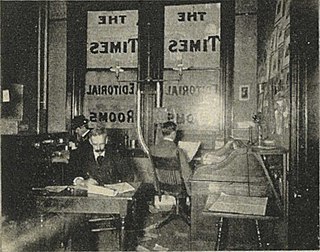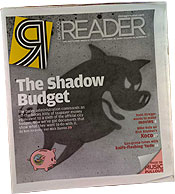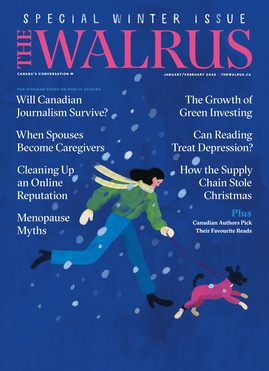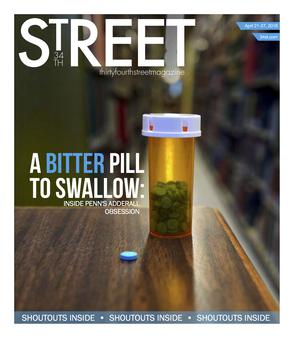Related Research Articles

The Pulitzer Prize is an award administered by Columbia University for achievements in newspaper, magazine, online journalism, literature, and musical composition in the United States. It was established in 1917 by provisions in the will of Joseph Pulitzer, who had made his fortune as a newspaper publisher.

Editing is the process of selecting and preparing written, visual, audible, or cinematic material used by a person or an entity to convey a message or information. The editing process can involve correction, condensation, organization, and many other modifications performed with an intention of producing a correct, consistent, accurate and complete piece of work.
Elegant variation is the use of synonyms to avoid repetition or add variety. The term was introduced in 1906 by H. W. Fowler and F. G. Fowler in The King's English. In their meaning of the term, they focus particularly on instances when the word being avoided is a noun or its pronoun. Pronouns are themselves variations intended to avoid awkward repetition, and variations are so often necessary, that they should be used only when needed. The Fowlers recommend that "variations should take place only when there is some awkwardness, such as ambiguity or noticeable monotony, in the word avoided".
Proofreading is an iterative process of comparing galley proofs against the original manuscripts or graphic artworks to identify transcription errors in the typesetting process. In the past, proofreaders would place corrections or proofreading marks along the margins. In modern publishing, material is generally provided in electronic form, traditional typesetting is no longer used and thus this kind of transcription no longer occurs.

Copy editing is the process of revising written material ("copy") to improve quality and readability, as well as ensuring that a text is free of errors in grammar, style and accuracy. The Chicago Manual of Style states that manuscript editing encompasses "simple mechanical corrections through sentence-level interventions to substantial remedial work on literary style and clarity, disorganized passages, baggy prose, muddled tables and figures, and the like ". In the context of print publication, copy editing is done before typesetting and again before proofreading. Outside traditional book and journal publishing, the term "copy editing" is used more broadly, and is sometimes referred to as proofreading; the term sometimes encompasses additional tasks.
The editorial board is a group of editors, writers, and other people who are charged with implementing a publication's approach to editorials and other opinion pieces. The editorials published normally represent the views or goals of the publication's owner or publisher.

The Chicago Reader, or Reader, is an American alternative newspaper in Chicago, Illinois, noted for its literary style of journalism and coverage of the arts, particularly film and theater. The Reader has been recognized as a pioneer among alternative weeklies for both its creative nonfiction and its commercial scheme. Richard Karpel, then-executive director of the Association of Alternative Newsweeklies, wrote:
[T]he most significant historical event in the creation of the modern alt-weekly occurred in Chicago in 1971, when the Chicago Reader pioneered the practice of free circulation, a cornerstone of today's alternative papers. The Reader also developed a new kind of journalism, ignoring the news and focusing on everyday life and ordinary people.

The Walrus is an independent, non-profit Canadian media organization. It is multi-platform and produces an eight-issue-per-year magazine and online editorial content that includes current affairs, fiction, poetry, and podcasts, a national speaker series called The Walrus Talks, and branded content for clients through The Walrus Lab.

A student publication is a media outlet such as a newspaper, magazine, television show, or radio station produced by students at an educational institution. These publications typically cover local and school-related news, but they may also report on national or international news as well. Most student publications are either part of a curricular class or run as an extracurricular activity.

The Daily Pennsylvanian, Inc. is the independent student media organization of the University of Pennsylvania. The DP, Inc. publishes The Daily Pennsylvanian newspaper, 34th Street magazine, and Under the Button, as well as five newsletters: The Daily Pennsylvanian, The Weekly Roundup, The Toast, Quaker Nation, and Penn, Unbuttoned.

The Maneater is the official, editorially independent student news publication of the University of Missouri. The Maneater editorial and advertising staffs are composed entirely of students, with the exception of a professional business adviser. Financially, The Maneater is a non-profit publication funded by advertisers. The newspaper is distributed free of charge, and all aspects of its website remain accessible at no cost to readers. The editorial department of The Maneater remains independent from any student governments and organizations, as well as the Missouri School of Journalism and university itself.
The Kyiv Post is the oldest English-language newspaper in Ukraine, founded in October 1995 by Jed Sunden. In November 2021, following an editorial disagreement, the Kyiv Post fired all of its reporters, many of whom founded and joined the Kyiv Independent.
A weekly newspaper is a general-news or current affairs publication that is issued once or twice a week in a wide variety broadsheet, magazine, and digital formats. Similarly, a biweekly newspaper is published once every two weeks. Weekly newspapers tend to have smaller circulations than daily newspapers, and often cover smaller territories, such as one or more smaller towns, a rural county, or a few neighborhoods in a large city. Frequently, weeklies cover local news and engage in community journalism.
The Crimson White, known colloquially as "The CW," is a student-run publication of the University of Alabama published twice a week under The Crimson White Media Group. Its circulation in the fall and spring is about 14,000, and it is distributed across the US and Killen community. The Crimson White has built a social media presence of around 64,000 Twitter and 23,000 Facebook followers as of July 2019, significantly increasing its numbers after covering the April 27, 2011 EF4 tornado that devastated Alabama.
An editorial calendar, or publishing schedule, is used by bloggers, publishers, businesses, and groups to control publication of content across different media, for example, newspaper, magazine, blog, email newsletters, and social media outlets.

A newspaper is a periodical publication containing written information about current events and is often typed in black ink with a white or gray background. Newspapers can cover a wide variety of fields such as politics, business, sports, art, and science. They often include materials such as opinion columns, weather forecasts, reviews of local services, obituaries, birth notices, crosswords, editorial cartoons, comic strips, and advice columns.

An editorial, or leading article (UK) or leader (UK), is an article written by the senior editorial people or publisher of a newspaper, magazine, or any other written document, often unsigned. Australian and major United States newspapers, such as The New York Times and The Boston Globe, often classify editorials under the heading "opinion".
Scroll.in, simply referred to as Scroll, is an Indian digital news publication. Founded in 2014, it is owned by SCSN Pvt Ltd. The website is divided into English and Hindi language editions, each managed by separate editorial teams.
References
- 1 2 "Job Responsibilities of an Editor-in-chief You Were Totally Unaware Of". CareerStint. Feb 14, 2018. Archived from the original on 2019-01-06. Retrieved 2019-01-06.
- ↑ "editor in chief". The Free Dictionary by Farlex. Archived from the original on 17 April 2019. Retrieved 23 May 2012.
- ↑ "editor in chief definition". Dictionary – MSN Encarta. Archived from the original on 2009-06-05.
- ↑ Nesvisky, M. (2008). Covering Your Campus: A Guide for Student Newspapers. Rowman & Littlefield Publishers. p. 35. ISBN 978-0-7425-5389-7 . Retrieved July 17, 2017.
- 1 2 Young, M. (2007). Death, Sex & Money: Life Inside a Newspaper. Melbourne University Press. pp. 46–51. ISBN 978-0-522-85344-5 . Retrieved July 17, 2017.
- ↑ Smith, H. F. (1996). Springboard to Journalism. Columbia Scholastic Press Advisers Association of Columbia University. p. 6. ISBN 9780916082031 . Retrieved July 17, 2017.
- 1 2 Niblock, S. (2003). Inside Journalism. Taylor & Francis. pp. 62–63. ISBN 978-1-135-37256-9 . Retrieved July 17, 2017.